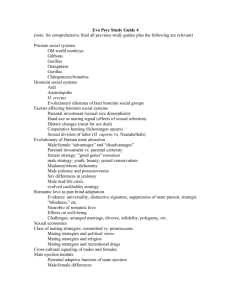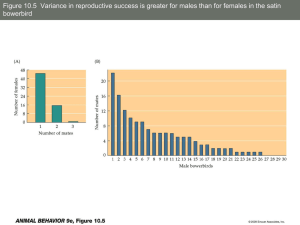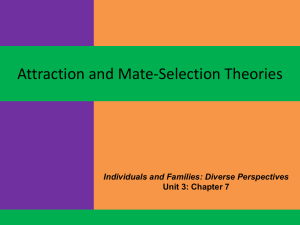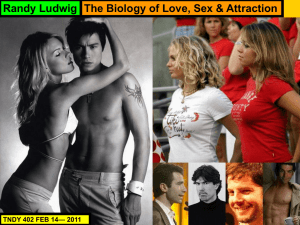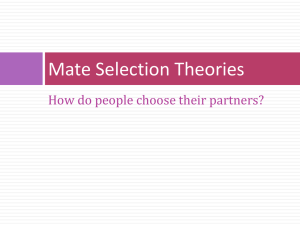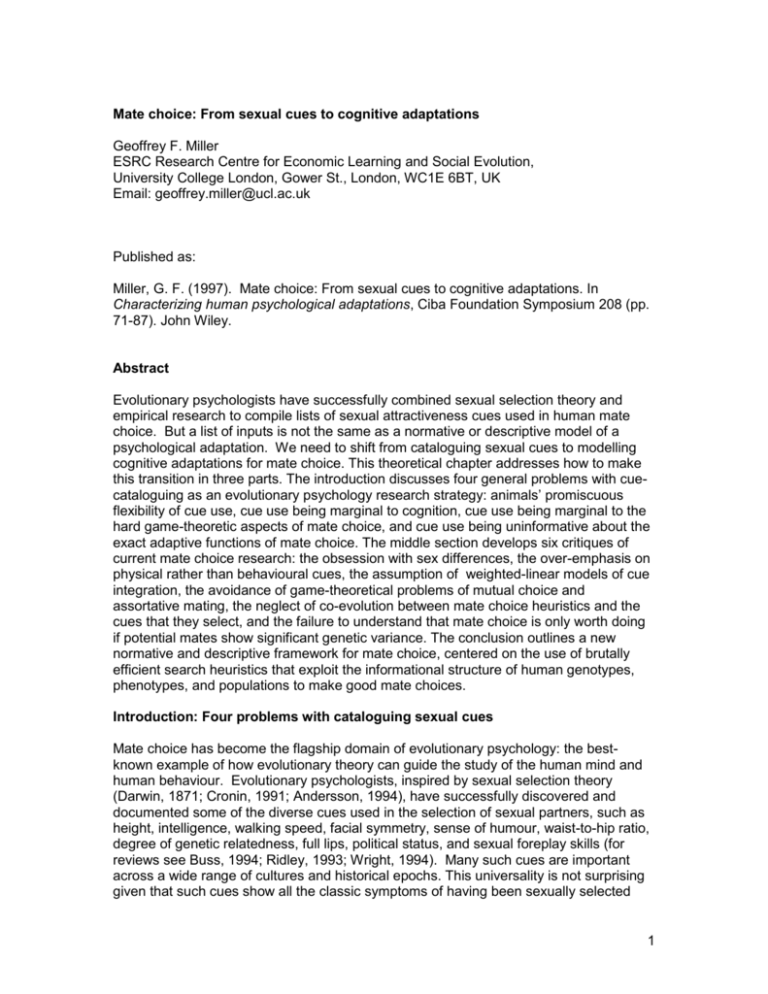
Mate choice: From sexual cues to cognitive adaptations
Geoffrey F. Miller
ESRC Research Centre for Economic Learning and Social Evolution,
University College London, Gower St., London, WC1E 6BT, UK
Email: geoffrey.miller@ucl.ac.uk
Published as:
Miller, G. F. (1997). Mate choice: From sexual cues to cognitive adaptations. In
Characterizing human psychological adaptations, Ciba Foundation Symposium 208 (pp.
71-87). John Wiley.
Abstract
Evolutionary psychologists have successfully combined sexual selection theory and
empirical research to compile lists of sexual attractiveness cues used in human mate
choice. But a list of inputs is not the same as a normative or descriptive model of a
psychological adaptation. We need to shift from cataloguing sexual cues to modelling
cognitive adaptations for mate choice. This theoretical chapter addresses how to make
this transition in three parts. The introduction discusses four general problems with cuecataloguing as an evolutionary psychology research strategy: animals’ promiscuous
flexibility of cue use, cue use being marginal to cognition, cue use being marginal to the
hard game-theoretic aspects of mate choice, and cue use being uninformative about the
exact adaptive functions of mate choice. The middle section develops six critiques of
current mate choice research: the obsession with sex differences, the over-emphasis on
physical rather than behavioural cues, the assumption of weighted-linear models of cue
integration, the avoidance of game-theoretical problems of mutual choice and
assortative mating, the neglect of co-evolution between mate choice heuristics and the
cues that they select, and the failure to understand that mate choice is only worth doing
if potential mates show significant genetic variance. The conclusion outlines a new
normative and descriptive framework for mate choice, centered on the use of brutally
efficient search heuristics that exploit the informational structure of human genotypes,
phenotypes, and populations to make good mate choices.
Introduction: Four problems with cataloguing sexual cues
Mate choice has become the flagship domain of evolutionary psychology: the bestknown example of how evolutionary theory can guide the study of the human mind and
human behaviour. Evolutionary psychologists, inspired by sexual selection theory
(Darwin, 1871; Cronin, 1991; Andersson, 1994), have successfully discovered and
documented some of the diverse cues used in the selection of sexual partners, such as
height, intelligence, walking speed, facial symmetry, sense of humour, waist-to-hip ratio,
degree of genetic relatedness, full lips, political status, and sexual foreplay skills (for
reviews see Buss, 1994; Ridley, 1993; Wright, 1994). Many such cues are important
across a wide range of cultures and historical epochs. This universality is not surprising
given that such cues show all the classic symptoms of having been sexually selected
1
during human evolution: they distinguish humans from other apes, men from women,
and adults from juveniles; they have high costs and complexity so function as reliable
indicators of health and developmental homeostasis; and they have exaggerated
aesthetic features that play upon the intrinsic perceptual biases of our nervous systems
(see Miller, in press, a). These universal cues of attractiveness are the informational
inputs to our psychological adaptations for mate choice.
However, imagine a software engineer’s reaction if one of her programmers, charged
with designing an algorithm to solve a difficult artificial intelligence problem, returned with
nothing more than a list of potentially relevant input variables. The hard part of cognitive
engineering is not identifying the inputs, but knowing how to combine them in contextsensitive ways to yield adaptive behaviour. The same holds in evolutionary psychology.
Describing the perceptual cues used by a psychological adaptation is just the first and
often easiest step in characterizing the adaptation. I am worried that the evolutionary
psychology of mate choice may get stuck at this step, producing an ever-expanding
catalogue of cues demonstrated to have a statistically significant effect on attractiveness
judgements in laboratory experiments, but never progressing to detailed, testable
models of the cognitive adaptations that exploit these cues to make real mate choices.
One could argue that we should wait to find all the sexual cues before we try to combine
them in a cognitive model of mate choice: building blocks first, architectural plans later.
But this building-block approach will fail for many of the same reasons that evolutionary
psychologists believe non-Darwinian psychology has failed. First, there is Brunswik’s
(1956) problem of “vicarious functioning”: animals are notoriously opportunistic in their
use of cues. Brunswik argued that “systematic designs”, where a single cue’s value is
varied and its behavioural effects are measured, are a powerful way of finding out what
cues can affect behaviour in the psychology laboratory, but are an extremely weak way
of finding out what cues are most informative and most often used under natural
conditions, or how such cues are integrated to guide adaptive behaviour. People almost
never admit indifference in mate choice, so almost any cue distinguishing two potential
mates in the laboratory can reliably yield an effect on choice behaviour, whether or not
the cue has much ecological validity.
Second, the longer and more diverse our cue-catalogue becomes, the easier it will be for
critics of evolutionary psychology to claim that general-purpose associative learning
mechanisms could account for human mate choice, by correlating pre-processed cues
with desired behavioural outcomes. If evolutionary psychology produces nothing more
than cue-catalogues, evolved adaptations will continue to be marginalized to the
periphery of cognition, in low-level perception and in the motivational systems that guide
associative learning. Mate choice reaches deep into the heart of cognition – judgement,
decision-making, and reasoning – so gives evolutionary psychology a fertile opportunity
for showing why even cognition must be a set of domain-specific adaptations. But so,
far, that opportunity has been wasted by obsessing about sexual cues.
Third, cataloguing attractiveness cues makes it easy to avoid modelling the intricacies of
mate choice as an interactive social problem of search, assessment, courtship,
competition, and mutual choice. The evolutionary psychology of mate choice is mostly,
so far, the psychology of what happens in the first five minutes of a single virgin picking
favourites from a line-up of passive strangers on a desert island. This Pleistocene
tropical fantasy is pleasant for the sexually frustrated graduate student or divorced
2
professor to contemplate precisely because it ignores the horrid game-theoretic
interdependency of real-world mate choice.
Fourth, cataloguing cues makes it easy to avoid specifying the adaptive goals of mate
choice in much detail. This is because attractiveness cues correlate with virtually every
other aspect of an organism’s phenotype (for technical reasons of developmental
epistasis, physiological condition-dependence, and genetic linkage reinforced by
assortative mating), rendering any cue a pretty good indicator of almost any underlying
trait that might be worth selecting. Only when we investigate combinations of cues that
indicate different trade-offs between desirable traits such as parenting ability, current
fertility, social status, and immunocompetence, will we be pushed to develop more
specific normative and descriptive models of mate choice. These four problems –
animals’ promiscuous flexibility of cue use, cue use being marginal to cognition, cue use
being marginal to the hard game-theoretic aspects of mate choice, and cue use being
uninformative about exact adaptive functions – make cue-cataloguing a rather weak
method for characterizing our adaptations for mate choice. The next sections describe
in more detail some pitfalls of cue-cataloguing compared to cognitive modelling; then the
conclusion will outline a normative and descriptive alternative.
Critiques and extensions of current research
There’s more to analyzing mate choice than predicting sex differences
Sex differences are easy to investigate because the contrast groups (males and
females) come ready-made, predictions from sexual selection theory are often fairly
simple, and results attract widespread media interest. But there’s much more to mate
choice than sex differences. Modern sexual selection theory provides a framework for
analyzing one of the most important decision domains faced by all sexually reproducing
animals. The theory would be as illuminating if we were hermaphrodites as it is given
our two sexes. Although males and females reliably differ in some of the traits they seek
and the cues they use, the basic game-theoretic problem of attracting the best mate who
will accept you remains very similar for both sexes. I am worried that in the popular
media and even in the minds of some evolutionary psychologists, the study of mate
choice has become synonymous with the study of sex differences in the relative weights
given to certain cues of attractiveness.
While sexual dimorphism usually indicates sexual selection, not all sexual selection
produces sexual dimorphism (see Andersson, 1994). If evolutionary psychology
assumes that all sexually monomorphic traits (e.g. human language, intelligence, and
creativity) evolved without any help from sexual selection, we prematurely rule out one of
the most powerful, inventive, and pervasive selection forces in nature (see Miller & Todd,
1995). Also, while mate choice mechanisms may show sexual dimorphism at the level
of cue perception, they may not at higher cognitive and strategic levels. Males and
females face largely similar problems assessing potentially deceptive cues, integrating
cues, searching through a sequence of prospects, and finding the best mate who will
accept them. These strategic problems will continue to be overlooked if we equate mate
choice with sexual dimorphism in the traditional, rather crude way.
From physical to behavioural cues
3
An irony of evolutionary psychology is that many mate choice researchers have
emphasized the sexual cues that are least psychological: physical attractiveness cues.
Faces, breasts, buttocks, muscles, penises, symmetry, height, and other morphological
traits have all been subject to intense analysis, while psychological traits such as
intelligence, creativity, personality, sense of humour, social skills, kindness, and ideology
have received mostly lip service (see Buss, 1994; Ridley, 1993). The reasons are
twofold: the ease of experimentally manipulating stimuli that represent morphological
traits, and the importance of physical attractiveness as a convenient, low-cost “filtering
cue” early in courtship. Evolutionary psychology’s focus on the physical is a reasonable
first step if our goal is demonstrating that there exist human universals of attractiveness,
contra the claims of some cultural anthropologists and humanities scholars. But if our
goal is to analyze our most important and distinctive mating strategies, selection criteria,
and courtship traits, then we must analyze how people make mate choices based on
psychological features. The payoffs could be significant. Whereas models of mate
choice based on physical traits can only explain the evolutionary origins of our bodies,
models that include psychological traits may explain the origins of our most distinctive
mental capacities (see Miller, in press, a, b). The co-evolution between mate choice
mechanisms and the courtship behaviours that they select puts the study of mate choice
at the very heart of evolutionary psychology, because we are studying the core
psychological adaptations that catalyze the emergence of other psychological
adaptations via sexual selection.
Beyond weighted linear models of cue integration
Many mate choice researchers seem to assume that organisms register a set of cues
associated with each potential mate, attach some standard weight to each cue, and then
add the weights together to arrive at an overall rating of attractiveness. Such “weightedlinear” models of cue integration, derived from Brunswik (1955) and revived in some
recent neural network models, seem like the simplest way to start an analysis, and make
it easy to interpret subjects’ numerical responses on questionnaires about the relative
importance of different attractiveness cues (see Buss, 1994). But the apparent cognitive
simplicity of weighted linear models may be deceptive. Gigerenzer and Goldstein (in
press) have analyzed several alternatives to weighted-linear integration that make better
decisions, using less information, operating faster, and better fitting some subjects’ thinkaloud protocols. Their “Take the Best” heuristic, for example, would be a fast, frugal way
to decide which of two prospects has higher mate value. This heuristic checks each
prospect on one cue at a time, with the cues ranked in order of their ecological validity
(correlation between cue value and mate value). The first cue that distinguishes the
prospects would be used to make one’s mate choice. If subjects using this Take the
Best heuristic were asked for their “cue weights”, they would find it a meaningless
question, and might report some other quantity (such as ecological validity,
discrimination rate, recency of cue use, or cue ranking) on a questionnaire. Use of such
heuristics may explain the puzzling finding that in many domains, subjects claim to use
more cues than prove significant in post-hoc multiple regression analyses of their
decisions. This is exactly what we would expect from Take the Best: the vast majority of
decisions many be determined by the few top-ranked cues, but where those cues don’t
distinguish between prospects, subjects must use lower-ranked cues to decide.
Another reason for questioning weighted-linear models is that the assessment costs of
different features used in mate choice are so wildly disparate. Morphological features
such as face and body shape can be assessed in a momentary glance, whereas
4
resourcefulness in emergencies, parenting skills, and capacity for avoiding sexual
boredom can be assessed only after months of interaction. A depth-first search for all
cue values in every prospect you encounter would be an idiotic way to search for a
mate. Instead, people use the easily-assessed physical cues as filtering devices to
decide who to talk to; they use conversations to decide who to have sex with; and they
use sexual relations and capacity for intimacy to decide who to have children with. What
is the relative “weight” then, of facial beauty, versus wit in conversation, versus foreplay
skills? The question is meaningless, if people are integrating these cues sequentially,
nonlinearly, and intelligently, rather than according to a weighted-linear method that
ignores cue assessment costs.
Moreover, this sequential cue-integration heuristic would produce behaviour that could
be misinterpreted all too easily as reflecting distinctive cue-weightings for short versus
long-term mating (cf. Buss, 1994). People would start relationships with prospects they
find physically attractive, but only continue relationships with those they find
psychologically compatible. Post-hoc, it would look as if they attached a higher “weight”
to physical attractiveness for short-term matings, and a higher “weight” to psychological
features for long-term matings. But the apparent correlation between cue weight and
relationship duration could be an artefact of some cues taking longer to assess than
others, with relationships ending only when someone becomes unhappy with the most
recent information they learned about their partner. To investigate sequential cue
integration heuristics, we need fewer questionnaire studies and single-cue experiments,
and more detailed interviews (we can call them “protocol analyses” if that helps get them
published) in which we actually listen to what people say about how they confront the
selective, biased, deceptive trickles of information that their would-be partners leak to
them.
Mutual choice, two-sided matching, and assortative mating
Although sexual harassment by males is endemic in nature, most matings seem to
require mutual consent. This mutual choice constraint complicates matters, because
fulfilling two sets of preferences in mating is multiplicatively harder than fulfilling one (for
discussion of this problem in sexual selection simulations, see Miller & Todd, 1993).
Nevertheless, evolutionary psychologists are fortunate that economists have already
done some hard thinking about how mutual choice works in mating markets. This is in
the literature of several hundred papers on “two-sided matching” (see Roth &
Sotomayor, 1990) which, as far as I know, has never previously been cited or discussed
in evolutionary psychology. A prototypical two-sided matching analysis assumes a
population of men and women, where each individual has a complete and transitive set
of preferences across members of the opposite sex (based on some unspecified
assessment process). A “stable matching” is defined as a pairwise assortment of men
and women such that no individual would prefer to be paired to someone else, who
would also prefer to be paired to them. In game theory terms, a stable matching is a
Nash equilibrium in the mating market. One heartening result from this literature is that
at least one stable matching exists for every mating market with two sexes (Gale &
Shapley, 1962). Further, no stable matching exists for mating markets with one or three
sexes (Roth & Sotomayor, 1990).
Moreover, a simple algorithm called the “deferred acceptance procedure” is guaranteed
to find a stable matching pretty quickly (Roth & Sotomayor, 1990). In this procedure,
one sex proposes, and the other sex accepts or rejects. For example, each man first
5
proposes to his most-favoured women. Each woman rejects any suitors who are
unacceptable, and each woman who receives more than one proposal rejects all but her
most preferred. Any man not yet rejected is kept “engaged”. The procedure then
iterates, with any man rejected on a previous step proposing to his next most preferred
woman. Engaged women can switch if a more-preferred man proposes to her. The
algorithm stops after any step in which no man is rejected. Women who did not receive
any acceptable proposals, and men rejected by all women acceptable to them, stay
single. If preferences are strict, then the set of people who remain single is the same for
all stable matchings. Surprisingly, if preferences are strict and if there are multiple stable
matchings, the deferred acceptance procedure with men proposing will always find the
matching that is most preferred by men and least preferred by women, while the reverse
is true if women propose.
This leads to a strange corollary: although men in mating markets are supposedly
competing with each other, once they realize the game-theoretic implications of mutual
choice, they can recognize their common interest in devising a matching procedure that
attains their most preferred stable matching. This “male-optimal” matching makes men
as happy as they could be, given the preferences women actually have, and makes
women as miserable as they could be given a stable matching. Whichever sex
proposes will reach its most preferred Nash equilibrium in the mating game. Moreover, I
suspect that given monogamy, the preferences of the proposing sex could be shown to
constitute stronger sexual-selection pressures than the preferences of the other sex.
These results also suggest that, if some assortative mating procedures are more
efficient than others in attaining stable matchings, then group selection could favour
such mating procedures, without having to overcome any individual-level selection
(Miller, 1994a). These matching results should be more broadly appreciated by
evolutionary psychologists, because they identify confluences and conflicts of interest
that would otherwise be overlooked.
Co-evolution of mate choice heuristics and the cues they select
Although mate choice heuristics are selected to exploit the sexual cues available in the
environment, those cues themselves are heritable traits that are selected by the choice
heuristics. This leads to a particularly fast, capricious, and dynamic form of co-evolution
(Miller & Todd, 1995; Todd & Miller, 1993, in press). The diversity of sexually-selected
traits and mate preferences across even closely-related species illustrates the speed
and power of this co-evolution. Indeed, examination of secondary sexual traits,
genitalia, and courtship behaviour is often the only way of distinguishing between sibling
species (no surprise, really, since mate preferences are what define species in the first
place.)
The co-evolution between sexual traits and mate preferences seems to give
evolutionary psychology no logical place to start in analyzing mate choice. But there
are patterns to the co-evolution that run quite deep. For example, Zahavi’s original
“handicap theory” was essentially a theory about how the reliability of sexual cues as
viability-indicators co-evolves with the mate preferences that select them (see
Andersson, 1994). His analysis, informed by game theory, suggested that sexual cues
will typically evolve to show an intermediate degree of ecological validity (i.e. correlation
with the trait they advertise), because only such intermediate degrees of reliability are
evolutionarily stable. Also, analysis of some intrinsic perceptual biases that shape the
evolution of sexual cues has led Ryan and Keddy-Hector (1992) to discover some
6
aesthetic principles for courtship displays. Likewise, a better understanding of
assortative mating should lead to predictions concerning typical levels of genetic linkage
and phenotypic intercorrelation between sexual cues, since assortative mating tends to
concentrate heritable high-quality cues in certain offspring. Rather than viewing either
sexual cues or mate preferences as givens in our analysis of mate choice, we should
view them as co-evolving traits that sometimes reach predictable, evolutionarily stable
equilibria, and that other times fly off together in runaway processes that still obey
certain evolutionary principles of signalling, advertisement, and assortative mating.
Mate choice and genetic variance
Mate choice research reveals a curious tension within evolutionary psychology
concerning within-species genetic variance. On one hand, evolutionary psychologists
downplay genetic differences within our species as superficial variants on a speciestypical body plan and cognitive architecture. This is because complex adaptations are
likely to pervade populations in monomorphic form, lest sexual recombination break
apart the co-adapted genes that grow the adaptations (Tooby & Cosmides, 1990). Such
arguments have given evolutionary psychology a good pretext for distancing itself from
the politically contentious research fields that study genetic variance in modern humans,
such as behavioural genetics, psychometrics, and Darwinian anthropology. On the other
hand, mate choice is only worth doing if genetic variance is of sufficient functional
importance to make the benefits of choosing well exceed the substantial search and
assessment costs of mate choice (Pomiankowski, 1987). The major reason for mate
choice in most sexually-reproducing species is that the genetic quality of your mate
determines half the genetic quality of your offspring. Phenotypes are fugitive, but genes
are forever. From this perspective, in-species genetic variance is literally the selective
environment to which mate choice has adapted. So, how could there be an evolutionary
psychology of mate choice, if mate choice requires a level of in-species genetic variance
that evolutionary psychology denies could exist?
Three recent developments in sexual selection theory have illuminated this genetic
variance issue. First, the gradual recognition that most mutations are harmful has led
theorists to propose that this pervasive “biased mutation” is a major reason why mate
choice remains worth doing even when adaptations have been under strong stabilizing
selection (Pomiankowski, Iwasa, & Nee, 1993). Adaptations are continually eroded by
this biased mutation, and mate choice is one of the best ways to counteract such
entropy.
Second, whenever sexual selection operates like a “winner-take-all” contest, as in
polygyny, evolution favours risk-seeking behaviour – not only risky competitive
behaviour as in violent conflict between males (Daly & Wilson, 1988), but also genetic
modifiers that maximize genetic and phenotypic variance (Pomiankowski & Moller,
1995). Such modifiers explain why sexually-selected traits typically show much higher
coefficients of additive genetic variance than survival traits (Pomiankowski, 1993). I
have argued elsewhere that some of our most distinctive psychological adaptations,
particularly our capacities for language, art, music, ideology, and creativity, evolved
largely under sexual selection (Miller, 1993, in press, a, b). If so, then such capacities
would be expected to show quite high genetic variance, especially in males. This may
explain why some of our most complex psychological adaptations, such as intelligence
7
measured by IQ tests, are also the most genetically variable and heritable (Miller,
1994b).
Third, sexual selection theorists are recognizing that, while random mating would break
apart co-adapted gene complexes to yield monomorphic adaptations within a population,
strong assortative mating can maintain relatively complex specializations in polymorphic
equilibria. Indeed, speciation itself can be viewed simply as the most extreme form of
assortative mating (Miller & Todd, 1993). If species (i.e. self-defining reproductive
communities with different mate choice and courtship adaptations) can maintain
separate adaptations, then perhaps less extreme forms of assortative mating can
maintain less obvious, but still significant, polymorphisms within a species. Also,
assortative mating can maintain genetic variance at much higher levels than random
mating, so perpetuates its own incentives for mate choice.
Conclusion: Towards a new normative and descriptive framework
Information flows successively from environment through perception, then cognition,
decision-making, and action. But selection pressures flow the opposite way, shaping
behavioural output most strongly, and trickling back to shape cognition only insofar as it
guides adaptive decision-making, and perception only insofar as it guides adaptive
cognition (see Miller & Todd, 1990). The fact that information and selection flow in
opposite directions through evolving minds puts the study of perception in a curious
quandary. From an information-processing viewpoint, low-level perceptual mechanisms,
such as those for registering cues of sexual attractiveness, look like the building blocks
of cognition. The ease with which experimental psychology can investigate such
mechanisms reinforces this impression. But from a selectionist viewpoint, low-level
perceptual mechanisms are not the building blocks of psychological adaptation at all, but
the last and most indirect products of selection pressures that have already determined
an adaptive task, a set of possible behaviours, a decision-making problem, and a
requisite set of cognitions.
In my view, evolutionary psychology has become prematurely focused on analyzing
sexual cues as perceptual inputs without a sufficient normative and descriptive
framework for understanding how these inputs should and could contribute to adaptive
mate choices in realistic social contexts. We must remember that mate choice is
fundamentally a problem of game-theoretic decision-making given skeptical prospects
and hostile competitors, not just a problem of optimal cue-integration and rational social
judgement. Animals encounter sexual prospects drawn from a fluid population with
unknown statistical distributions of attractiveness, fertility, and viability. Prospects
appear in unpredictable and often irrevocable order. Some features of prospects can be
assessed instantly, cheaply, and reliably; others can be discovered only after long,
expensive, and interactive courtship. Prospects also have unknown deviations from an
unknown population-typical set of mate preferences. Typically, one’s own attractiveness
and mate value can be inferred only indirectly. The strategies and attractions of one’s
competitors are even less accessible. Lost in this sea of uncertainty, deception,
competition, and coyness, you must try to combine your genes with the best genes that
you can attract, and combine your parental effort with the most fertile and viable mate
you can find.
Task complexities like this seem overwhelming, but evolution has two secret weapons:
the adaptations it constructs can ruthlessly exploit any available structure in the
8
environment, and they can shamelessly sacrifice generality, rationality, elegance,
simplicity, completeness, and perfection in favour of adaptive efficiency. We must
expect mate choice adaptations that take short-cuts, that use cheap and easily
perceived cues first, that put cues together in the order they’re available, and that rely on
social stereotypes whenever they’re more valid than not. Our descriptive models of
mate choice should draw not just on some recycled perceptual psychology, but on the
full range of information-processing heuristics wherever we can find them: judgement
and decision research, social cognition, artificial intelligence, economics, whatever. We
must be as inventive in developing models as evolution must have been in designing
mechanisms.
We should be equally pragmatic in developing better normative models for
understanding what adaptive efficiency means in mate choice, drawing not just from
sexual selection theory, but also game theory, decision theory, and statistics.
Principally, we must develop better ways of describing the task environment in which
mate choice operates: what is the sexual game being played, what are the payoffs, what
kinds of strategic decisions must be made, and what information is available for making
them? Mate choice mechanisms are adaptations, and adaptations are always
adaptations to something: a well-specified task and a well-specified environment. If we
try to model mate choice too directly, using little more than some basic sexual selection
theory combined with the narrow set of empirical methods favoured by psychology
journal editors, we won’t be capitalizing on the full power of our Darwinian framework.
This framework requires equal attention to analyzing environment structure, analyzing
adaptive tasks, and analyzing adaptations themselves. Analyzing environment structure
doesn’t just mean outlining an impressionistic reconstruction of Pleistocene social
dynamics. It means detailed, quantitative analysis of human genotypes, bodies, and
behaviours as informational structures on which mate choice mechanisms operate.
Analyzing the adaptive task in mate choice doesn’t just mean sketching how a despot
might maximize offspring number by picking nubile slave girls. It means detailed, explicit
analysis of mating games as played by ordinary humans, both ancestral and modern,
with all the complexities of mutual choice, assortative mating, affordability, commitment,
and deception. If we face these challenges, the technical achievements of mate choice
research might finally match its popularity.
Acknowledgements
This research was supported by NSF-NATO Post-Doctoral Research Fellowship RCD9255323, the University of Sussex, the University of Nottingham, the London School of
Economics, the Max Planck Society, and the ESRC. For comments on drafts, thanks
to Rosalind Arden, Helena Cronin, and Peter Todd.
References
Andersson M 1994 Sexual selection. Princeton U Press
Brunswik E 1956 Perception and the representative design of psychological
experiments (2nd ed) Univ California Press, Berkeley
Buss D M 1994 The evolution of desire: Human mating strategies. Basic Books, New
York
9
Cronin H 1991 The ant and the peacock: Altruism and sexual selection from Darwin to
today. Cambridge U Press
Daly M, Wilson M 1988 Homicide. Aldine, New York
Darwin C 1871 The descent of man, and selection in relation to sex. John Murray,
London
Gale D, Shapley L 1962 College admission and the stability of marriage. Amer Math
Monthly 69: 9-15
Gigerenzer G, Goldstein D In press Reasoning the fast and frugal way: Models of
bounded rationality. Psych Review
Miller GF 1993 Evolution of the human brain through runaway sexual selection: The
mind as a protean courtship device. Ph.D thesis, Stanford Psych Dept. Available
through UMI microfilms
Miller GF 1994a Beyond shared fate: Group-selected mechanisms for cooperation and
competition in fuzzy, fluid vehicles. Behav Brain Sciences 174: 630-631
Miller G F 1994b Why is male variance higher than female variance for human mental
traits? A sexual selection theory of risk-seeking. Talk at the Human Behavior and
Evolution Society Annual Conference, Albuquerque
Miller GF in press, a Sexual selection in human evolution: Review and prospects. In:
Crawford C, Krebs D (eds) Evolution and Human Behavior: Ideas, Issues, and
Applications. Lawrence Erlbaum
Miller GF in press, Protean primates: The evolution of adaptive unpredictability in
competition and courtship. In: Whiten A, Byrne RW (eds) Machiavellian Intelligence II.
Cambridge U Press
Miller GF, Todd PM 1990 Exploring adaptive agency I: Theory and methods for
simulating the evolution of learning. In: Touretsky DS, Elman JL, Sejnowski TJ, Hinton
GE (eds) Proc 1990 Connectionist Models Summer School. Morgan Kaufmann p 65-80
Miller GF, Todd PM 1995 The role of mate choice in biocomputation: Sexual selection as
a process of search, optimization, and diversification. In: Banzaf W, Eeckman, FH (eds)
Evolution and biocomputation: Computational models of evolution. Springer-Verlag p
169-204
Moller AP, Pomiankowski A 1993 Fluctuating asymmetry and sexual selection.
Genetica 89: 267-279
Pomiankowski A 1987 The costs of choice in sexual selection. J Theor Biology 128:
195-218
Pomiankowski A, Moller A 1995 A resolution of the lek paradox. Proc R Soc London B
260(1357): 21-29
10
Pomiankowski A, Iwasa Y, Nee S 1991 The evolution of costly mate preferences. I.
Fisher and biased mutation. Evolution 456: 1422-1430
Ridley M 1993 The red queen: Sex and the evolution of human nature. Viking, New
York
Roth AE, Sotomayor MAO 1990 Two-sided matcing: A study in game-theoretic
modeling and analysis. Cambridge U Press
Ryan MJ, Keddy-Hector A 1992 Directional patterns of female mate choice and the role
of sensory biases. Amer Naturalist 139: S4-S35
Todd PM, Miller GF 1993 Parental guidance suggested: How parental imprinting
evolves through sexual selection as an adaptive learning mechanism. Adaptive Behavior
21: 5-47
Todd PM, Miller GF In press. Biodiversity through sexual selection. In: Artificial Life V.
MIT Press
Tooby J, Cosmides L 1990 The past explains the present: Emotional adaptations and
the structure of ancestral environments. Ethol Sociobiol 114/5: 375-424
Wright R 1994. The moral animal: Evolutionary psychology and everyday life. Pantheon
Books, New York
11

